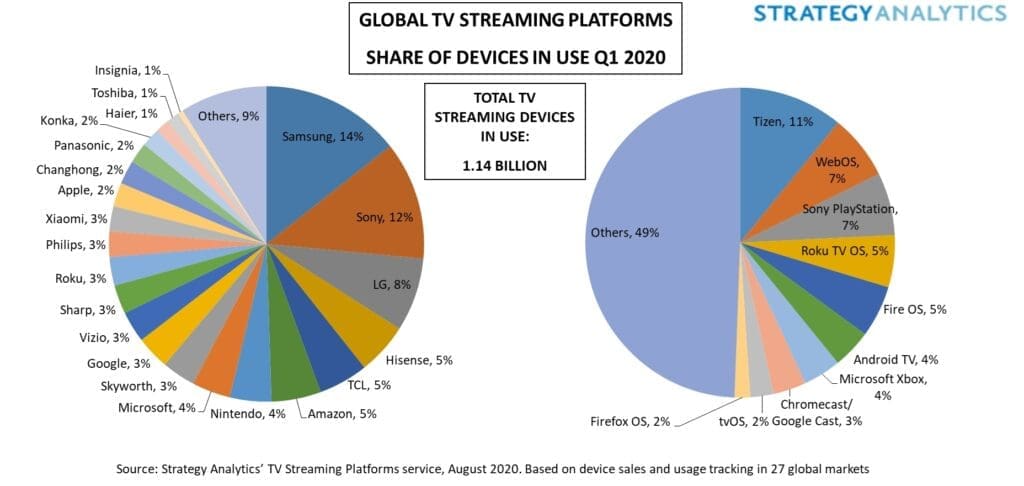
Distributing video content in 2021 can be a nightmare considering the number of different platforms and devices that exist today. OTT (over-the-top) devices are rapidly diversifying and allowing customers to use lower-priced devices for streaming content.
In this article, I’ll walk you through some of the major OTT devices and platforms, how they’ve changed over the years, and which ones might be best for your use case. I’ll also share some of the trends powering this proliferation of OTT devices and platforms to help you keep up.
OTT Device vs OTT Platform
An OTT device is any device that supports streaming video content through an internet connection. This could include a smart TV, Android or Apple TV, Amazon Fire TV Stick, or a gaming console.

An OTT platform on the other hand is a service around the OTT content or an interface between a consumer and an OTT device. Some popular OTT platform includes Netflix, Hulu, Amazon Prime, and Disney+.
Innovations Have Caused an Audience Explosion
Broadcast technologies and hardware innovations for streaming devices are increasing the audience for OTT platforms. Technology advancement has also made third-party devices pairable with your existing devices for streaming OTT content. For example, a few months back I switched to Airtel XStream as an OTT provider while still being on my old television device.
Manufacturers are also adding support for OTT messaging (WhatsApp and WeChat) and OTT audio applications (SoundCloud). As more and more devices supporting OTT content are released into the market, content distributors have to consider how new devices can be optimized for streaming OTT content.
The OTT Device Market Is Highly Fragmented
In 2015, there were 33 new OTT video services in the US alone. That’s amazing because that’s in addition to all the ones we all know about that are in all these devices, and we still haven’t even hit the point where the traditional companies are just going to fly into the TV with a direct consumer model, which is coming. – Matthew Durgin (LG Electronics Director, Smart TV Content)
TV operators have started offering their own subscription-based OTT services. In 2019, there were roughly 63,000 OTT devices among the preferred ones (ie: Laptops, PCs, and TVs). That’s three out of many other categories in the fragmented OTT device market. Over 87% of the smartphone market, a category in itself, is further fragmented due to distinctions in devices, models, and operating systems. Thus OTT distributors have to make sure they are catering to the device proliferation and fragmentation to stay ahead in the game.

Devices to Consider
Let’s look at some major OTT devices that you might want to consider for distributing video content in 2021.
Tizen
Tizen is Samsung’s proprietary operating system. Its popularity skyrocketed in 2020 with a 21% year-on-year increase in the number of Tizen smart TV devices used all over the world. It offers some advanced features in addition to OTT streaming, such as auto-detection of source devices connected, in-house gaming apps, syncing, and sharing between multiple devices.
Almost all modern smart TVs by Samsung run on Tizen OS. Samsung Smart Watches like Galaxy Gear, Galaxy Gear S series, Samsung Gear Fit, and Pro also run on Tizen OS. Some of Samsung’s popular smartphones like Z1 and Z3 also rely on Tizen OS—there are even some smart home appliances such as Samsung refrigerators that are powered by Tizen OS. Tizen’s in-vehicle infotainment software platform also enables it to support entertainment systems in vehicles.
LG WebOS
LG WebOS is a Linux-based operating system for smart TVs that comes along with an intuitive user experience. It has an embedded content management system where you can edit and play content remotely, the ability to view different content simultaneously on split screens, synchronized content playback, and support for ad campaigns.
LG’s smart TVs are all powered by LG WebOS and its latest version webOS 6.0 is licensed to RCA, Ayonz, and Konka among other TV manufacturers indicating that its market share is bound to grow in the coming years.
Gaming Consoles
Owning a gaming console today opens a plethora of entertainment services to the consumer such as browsing the web, listening to music, and of course, streaming content. In 2017, more than 3/4 of console owners were subscribed to at least one OTT service at a time.
Sony Playstation
The latest Playstation 5 and last gen’s Playstation 4 give you access to several free and paid streaming services such as Netflix, Disney+, and Amazon Prime. Sony even launched its own OTT streaming service, PlayStation Vue in 2015 for the US market.
Microsoft Xbox
In 2019, Microsoft sold approximately 6 million Xbox devices worldwide and shipped 3.3 million Xbox X consoles alone. Its most popular Xbox has sold more than 40 million units worldwide to date. Both Xbox X and Xbox S series come with Microsoft Entertainment, offering access to hundreds of OTT streaming services. Microsoft’s latest move of turning the Xbox into a smart TV app to access Xbox exclusive games on any smart TV is surely going to draw consumer’s attention.
Both brands offer a great insight into how their devices’ popularity among the youth provides huge potential for content distributors to convert the gaming audience into their customers.
Amazon Fire OS
Amazon Fire OS is a mobile-based operating system that powers several Amazon Fire TV variants, the more modern Fire TV stick, and a bunch of Amazon tablets today. It offers an experience much similar to Android and also runs a number of Android Apps without any additional requirements. In 2019, Amazon had over 40 million active Fire TV users worldwide and a year later, it became the world’s top-selling OTT streaming device.
Amazon is focused on acquiring more users and digital media streaming consumers by reaping the benefits of owning both an OTT streaming service as well as a device. With some intelligent branding and marketing, Amazon Fire Stick owners who haven’t subscribed to Amazon Prime yet can be easily converted to active Amazon Prime users. On the other hand, Amazon Prime users who have been using the OTT platform for quite some time are likely to be fascinated by an OTT device by the same brand. If your OTT service isn’t optimized to deliver a rich viewing experience to Amazon Fire TV Stick owners, it could be a potential deal-breaker for you.
Roku TV OS
Roku TV OS is the operating system powering Roku streaming players and Roku TV. Roku is dominating the North American streaming market and sold more TV sets in the US than popular manufacturers like LG and Samsung. In 2019, Roku took 15.2% of the OTT device market with more than 40 million devices out in the world. Its growing popularity has allowed it to expand in other sectors such as advertising and partnering with media companies to deliver consumer favorable content on its devices. As a leader in the space, Roku devices cover a large and incontestable sector of target devices for OTT producers.
Google Cast and Android TV
As with anything else software-related, Google is a giant in the OTT market. It offers two major OTT services, Google Cast and Android TV.
Google Cast
Google Cast is the software system powering Google’s popular multimedia streaming device Chromecast. Chromecast is a hardware dongle, similar to the Amazon Fire Stick, that offers a wide range of entertainment services. The beauty of Google Cast lies in the fact that it has practically no interface and your android device, laptop or tablet can be used as a remote. This gives the device an edge over others in terms of ease of use.
Android TV
Google’s Android TV is your smartphone’s Android OS in a TV set manufactured by partner brands like Sony, Hisense, Asus, and TCL. Its market share is huge and is bound to increase in the coming years. This can be attributed to the fact that the technical know-how for Android users on the device is negligible in comparison to its competitors. Thus Google Android TV mitigates the gap between using an android phone and a smart TV and offers several features such as voice assistant, tailored content, and built-in Chromecast.
Android TV vs Google Cast
Android TV is a superset of Google Cast, having all functionalities of its own as well as that of Google Cast. The former comes with a dedicated remote and User Interface with a large number of variants and pricing. Google Cast on the other hand is more portable and affordable but doesn’t have a dedicated remote or screen since it’s primarily used to cast a screen from a device to your Television. Both Android TV and Google Cast support a large number of apps but there’s a noticeable difference in terms of user experience for fast-paced gaming apps. Casting a gaming app from your smartphone could cause a lag and using your smartphone as a controller doesn’t bring an overwhelming gaming experience. On the other hand, Android TV offers a much better gaming experience and can be easily paired with external controllers.
Apple tvOS
When it comes to consumer electronics, Apple has always dominated with its superior branding, rich interface, and aggressive pricing. Currently, Apple TV holds 2% of the OTT devices market share and is constantly improving the experience for its users. The upcoming Apple TV 4K is expected to have an optimized gaming experience since it will run on the new A12 bionic chips powering the new Macs. It will also come with a Siri remote and intuitive colors for a wholesome viewing experience.
Business Model Comparison: Apple Music Store vs Apple TV
Comparing and contrasting the business model of Apple Music Store and Apple TV gives some interesting insights that can be valuable from an OTT content distribution standpoint.
Both have Apple’s own iTunes store as a key partner, share a large number of common channels such as Apple.com, all Apple devices, any device running iTunes, and the Apple app store. This implies that Apple can effectively convert their Apple Music users to Apple TV users and vice versa through brand loyalty.
Apple Music’s key partners include record labels, artists, third-party integrations, and web radio stations. On the other hand Apple Tv partners with content producers and distributors, OTT platforms like Netflix and Hulu, and video subscription portals of major American sports leagues. Apple Music caters to the large or mass market of music lovers targeting a generic customer base whereas Apple TV targets OTT consumers amongst existing Apple users. The net effect is an increase in overall Apple users to drive a loyalty-based customer acquisition to consequently drive revenues in the OTT space.
Apple TV is a physical device and comes with a one-time purchase cost. Apple Music Store has a three-month free trial post which you have to subscribe to one of their plans. Apple TV also comes with a one-year free subscription to their OTT platform Apple TV+.
Panasonic Firefox OS
Firefox OS powers Panasonic DX-series UHD TVs that have intuitive and customizable home screens with quick access to live OTT content, OTT streaming apps, and syncing with other devices. It also gives an optimized way to browse the web and stream web content from an Android device to your Panasonic Smart TV. You may think today that the Firefox OS is obsolete but it still powers a large number of OTT devices. It holds roughly 2% of the market share in the fragmented streaming devices industry.
Conclusion
There’s a huge opportunity for OTT content creators and distributors to tap into the vast device market to acquire more customers and scale revenue. However, innovations in technology and fragmentation in the device market pose a challenge of supporting distribution on a large number of unique target devices. This can be combated by creating customized video developer tools to deliver quality video streaming efficiently that’s also compatible across these devices. Building these tools, however, can be a daunting task considering the engineering complexity and expenses involved.
Bitmovin provides video player SDKs for Android, iOS, Roku, and WebOS supporting all the target devices discussed above along with a video streaming analytics tool to help you understand your customers intelligently. It also has a dedicated encoding API to optimize real-time video content delivery.
Video technology guides and articles
- Back to Basics: Guide to the HTML5 Video Tag
- What is a VoD Platform? A comprehensive guide to Video on Demand (VOD)
- Video Technology [2022]: Top 5 video technology trends
- HEVC vs VP9: Modern codecs comparison
- What is the AV1 Codec?
- Video Compression: Encoding Definition and Adaptive Bitrate
- What is adaptive bitrate streaming
- MP4 vs MKV: Battle of the Video Formats
- AVOD vs SVOD; the “fall” of SVOD and Rise of AVOD & TVOD (Video Tech Trends)
- MPEG-DASH (Dynamic Adaptive Streaming over HTTP)
- Container Formats: The 4 most common container formats and why they matter to you.
- Quality of Experience (QoE) in Video Technology [2022 Guide]



